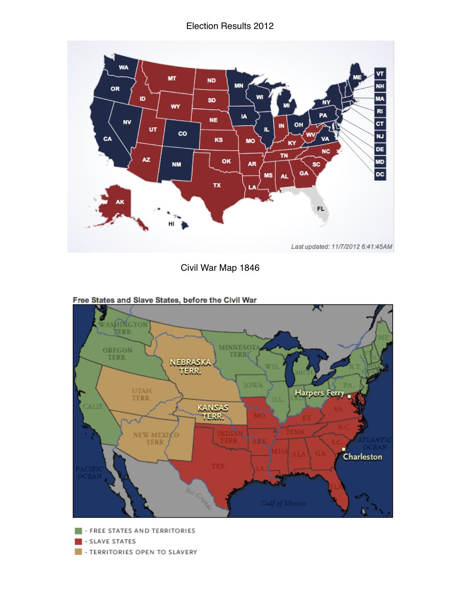Friday, November 9, 2012
Is Indiana atypical?
Indiana consistently votes Republican. It was a MAJOR surprise to everyone involved when Indiana barely went for Obama in 2008. This is not typical of the Midwest: for the last twenty years, in successful Democratic election years, Indiana sticks up out of the South like a sore red thumb. (When a Republican takes the White House, Ohio often keeps Indiana company. While Ohio is a swing state, though, Republicans can count on Indiana for its solid dozen-or-so electoral votes.)
Short question: Is this atypical? The question was prompted by this amusing picture:
There are five major exceptions to the pattern: New Mexico, Colorado, Virginia, Florida, and Indiana. With the exception of Indiana, we can predict the changes based on demographics: increases in the Hispanic population, and urbanization around the District of Columbia. But Indiana's demographics haven't significantly changed in the same way - so what's the deal?
So I compared Indiana to its close neighbor Illinois, using the New York Times' data on each state. Glancing at county-by-county results, we see broadly similar trends: mostly red, with urban areas and some traditionally Democratic counties blue. The glaring source of difference between Illinois and Indiana is Chicago. I crunched a few numbers (rounding to the nearest thousand and ignoring third-party candidates - those will account for discrepancies of a few percentage points).
Illinois has 20 electoral votes, and just over 5 million votes (5,006,000) were cast in the state. Just under 2 million (1,918,000) of them were cast in Cook County. Obama carried Illinois with 57% of the vote, 2,916,000 votes, while Romney received 43%, or 20,990,000 votes.
Indiana, meanwhile, has 11 electoral votes. In Indiana, 2,552,000 votes were cast, with 1,412,000 (or 54%) cast for Romney and 1,140,000 (44%) cast for Obama.
Let's suppose that Cook County just suddenly fell into Lake Michigan. What would happen to Illinois' vote totals? Well, instead of 5 million votes, only a handful more than 3 million votes would be cast (much closer to Indiana's 2.6 million total). Removing the Cook County voting from the Obama-Romney statewide totals gives Romney 1,611,000 votes to Obama's 1,477,000 votes. This is an edge of 52% - 48% to Romney (much closer to Indiana's 55%-45%). Romney would get Illinois' electoral votes ... but there wouldn't be 20 anymore. Crude scaling suggests there would be 12 electoral votes (hey, Indiana has 11!).
Neat, huh? If Illinois didn't have Chicago, it would function like Indiana's twin: A state with a couple of mid-sized, moderately dense cities (Indianapolis, Fort Wayne, Evansville, South Bend, ...) in a sea of rural conservative counties. A huge, dense urban area makes the difference between a reliable large Democratic state and a reliable mid-sized Republican state.
What about Ohio, Indiana's other neighbor? It doesn't have any one tremendously huge, dense urban area, nor does it have only a few - instead, it has several large, dense cities spread throughout the state (Cincinnati, Cleveland, Toledo, Columbus, Dayton, Youngstown). The urban/rural tension is finely balanced, so Ohio functions as a swing state.
Subscribe to:
Post Comments (Atom)

No comments:
Post a Comment